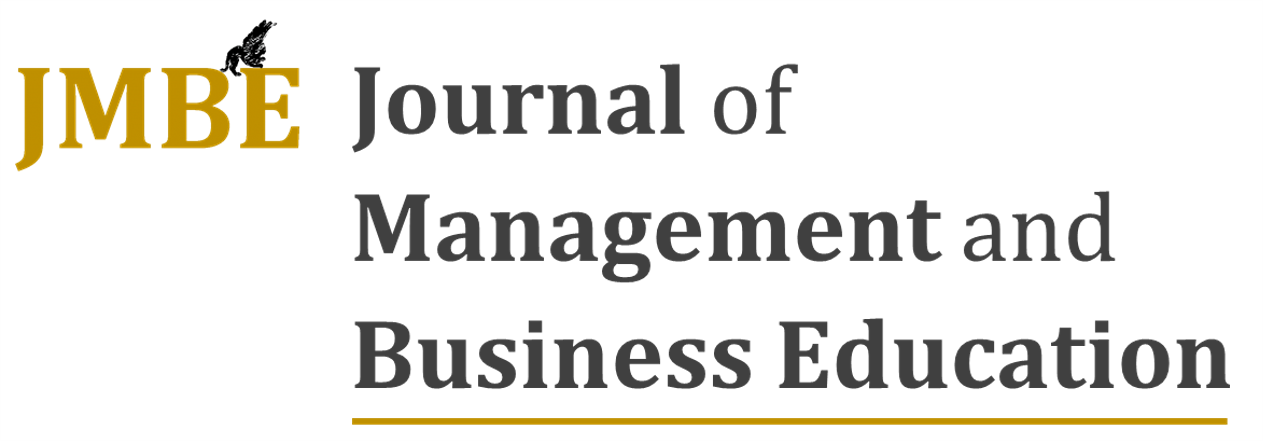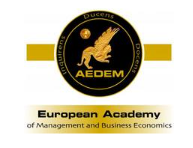Encouraging the state of flow: the key of business simulation games
DOI:
https://doi.org/10.35564/jmbe.2018.0011Keywords:
Business simulation games, flow, skills, game-based learningAbstract
Business simulation games present an interesting alternative to traditional teaching methods in Business and Economics. They reduce the gap between theory and practice, allowing students to develop different skills and competences. One of the factors that influences their success as a teaching tool is flow experience while playing. The aim of this study is to analyse whether business simulation games promote the conditions to experiment flow (i.e., balance of skills and challenge, clear goals, and immediate feedback), promote the state of flow (i.e., concentration, enjoyment, and intrinsic motivation), as well as the evolution of the state of flow during game play. In addition, we aim to analyse whether the use of business simulation games in the class helps students to develop skills and competences. An empirical study was carried out with 320 students who had played a business simulation game. The results obtained provide strong support for the use of business simulation games in class.
Downloads
References
Agarwal, R., & Karahanna, E. (2000). Time flies when you're having fun: Cognitive absorption and beliefs about information technology usage. Management Information Systems Quarterly, 24, 665-694.
https://doi.org/10.2307/3250951
Bakker, A. (2005). Flow among music teachers and their students: The crossover of peak experiences. Journal of Vocational Behavior 66, 26-44.
https://doi.org/10.1016/j.jvb.2003.11.001
Bakker, A. (2008). The work-related flow inventory: Construction and initial validation of the WOLF. Journal of Vocational Behavior 72, 400-414.
https://doi.org/10.1016/j.jvb.2007.11.007
Barzilai, S. & Blau, I. (2014). Scaffolding game-based learning: Impact on learning achievements, perceived learning, and game experiences. Computers & Education 70, 65-79.
https://doi.org/10.1016/j.compedu.2013.08.003
Bell, R. & Loon, M. (2015). The impact of critical thinking disposition on learning using business simulations. The International Journal of Management Education 13, 119-127.
https://doi.org/10.1016/j.ijme.2015.01.002
Ben-Zvi, T. (2010). The efficacy of business simulation games in creating Decision Support Systems: An experimental investigation. Decision Support Systems 49, 61-69.
https://doi.org/10.1016/j.dss.2010.01.002
Borrajo, F., Bueno, Y., de Pablo, I., Santos, B., Fernández, F., García, J. & Sagredo, I. (2010). SIMBA: A simulator for business education and research. Decision Support Systems 48, 498-506.
https://doi.org/10.1016/j.dss.2009.06.009
Coffey, B. & Anderson, S. (2006). The students' view of a business simulation: Perceived value of the learning experience. Journal of Strategic Management Education 3, 151-168.
Csikszentmihalyi, M. (1975). Beyond Boredom and Anxiety. San Francisco: Joseey-Bass.
Csikszentmihalyi, M. (1990). Flow: The Psychology of Optimal Experience. New York: HaperCollins.
Csikszentmihalyi, M. & Csikszentmihalyi, I. (1988). Optimal experience: psychological studies of flow in consciousness. Cambridge: Cambridge University Press.
https://doi.org/10.1017/CBO9780511621956
Doyle, D. & Brown, F.W. (2000). Using a business simulation to teach applied skills - the benefits and the challenges of using student teams from multiple countries. Journal of European Industrial Training 24(6), 330-336.
https://doi.org/10.1108/03090590010373316
Fitó-Bertran, A., Hernández-Lara, A., & Serradell-López, E. (2014). Comparing student competences in a face-to-face and online business game. Computers in Human Behavior 30, 452-459.
https://doi.org/10.1016/j.chb.2013.06.023
Fitó-Bertran, A., Hernández-Lara, A., & Serradell-López, E. (2015). The effect of competences on learning results: An educational experience with a business simulator. Computers in Human Behavior 51, 910-914.
https://doi.org/10.1016/j.chb.2014.11.003
Fu, F., Su, R., & Yu, S. (2009). EGameFlow: A scale to measure learners' enjoyment of e-learning games. Computers & Education 52, 101-112.
https://doi.org/10.1016/j.compedu.2008.07.004
Galea, C. (2001). Experiential simulations: Using web-enhanced role-plays to teach applied business management. Information Technology & Management 2(4), 473-489.
https://doi.org/10.1023/A:1011458819615
Garris, R., Ahlers, R., & Driskell, J. (2002). Games, motivation, and learning: A research and practice model. Simulation & Gaming 33(4), 441-467.
https://doi.org/10.1177/1046878102238607
Ghani, J., Supnick, R., & Rooney, P. (1991). The experience of flow in computer-mediated and in face-to-face groups. Proceedings of the Twelfth International Conference on Information Systems, 229-237.
Glover. I. (2013). Play As You Learn: Gamification as a Technique for Motivating Learners. Proceedings of World Conference on Educational Multimedia, Hypermedia and Telecommunications, 1999 - 2008.
Guo, Y. & Ro, Y. (2008). Capturing Flow in the Business Classroom. Decision Sciences Journal of Innovative Education 6(2), 437-462.
https://doi.org/10.1111/j.1540-4609.2008.00185.x
Hamari, J. & Koivisto, J. (2014). Measuring flow in gamification: Dispositional Flow Scale-2. Computers in Human Behavior 40, 133-143.
https://doi.org/10.1016/j.chb.2014.07.048
Hamari, J., Shernoff, D., Rowe, E., Coller, B., Asbell-Clarke, J., & Edwards, T. (2016). Challenging games help students learn: An empirical study on engagement, flow and immersion in game-based learning. Computers in Human Behavior 54, 170-179.
https://doi.org/10.1016/j.chb.2015.07.045
Hanux, M. & Fox, J. (2015). Assessing the effects of gamification in the classroom: A longitudinal study on intrinsic motivation, social comparison, satisfaction, effort, and academic performance. Computers & Education 80, 152-161.
https://doi.org/10.1016/j.compedu.2014.08.019
Hoffman, D. & Novak, T. (1996). Marketing in hypermedia computer-mediated environments: Conceptual foundations. Journal of Marketing 60, 50-68.
https://doi.org/10.1177/002224299606000304
Hou, H. & Li, M. (2014). Evaluating multiple aspects of a digital educational problem-solving-based adventure game. Computers in Human Behavior 30, 29-38.
https://doi.org/10.1016/j.chb.2013.07.052
Jackson, S. & Eklund, R. (2002). Assessing flow in physical activity: The Flow State Scale-2 and Dispositional Flow Scale-2. Journal of Sport & Exercise Psychology 24, 133-150.
https://doi.org/10.1123/jsep.24.2.133
Jackson, S. & Marsh, H. (1996). Development and validation of a scale to measure optimal experience: The flow state scale. Journal of Sport & Exercise Psychology 18, 17-35.
https://doi.org/10.1123/jsep.18.1.17
Kiili, K. (2005). Digital game-based learning: Towards an experiential learning model. The Internet and Higher Education 8, 13-24.
https://doi.org/10.1016/j.iheduc.2004.12.001
Kiili, K., Lainema, T., Freitas, S., & Sylvester, A. (2014). Flow framework for analyzing the quality of educational games. Entertainment Computing 5, 367-377.
https://doi.org/10.1016/j.entcom.2014.08.002
Klein, B., Rossin, D., Guo, Y., & Ro, Y. (2010). An examination of the effects of flow on learning in a graduate-level introductory operations management course. Journal of Education for Business 85, 292-298.
https://doi.org/10.1080/08832320903449600
Lainema, T. & Nurmi, S. (2006). Applying an authentic, dynamic learning environment in real world business. Computers & Education 47, 94-115.
https://doi.org/10.1016/j.compedu.2004.10.002
Lee, Y. & Choi, J. (2013). A structural equation model of predictors of online learning retention. The Internet and Higher Education 16, 36-42.
https://doi.org/10.1016/j.iheduc.2012.01.005
Loon, M., Evans, J., & Kerridge, C. (2015). Learning with a strategic management simulation game: A case study. The International Journal of Management Education 13, 227-236.
https://doi.org/10.1016/j.ijme.2015.06.002
Matute, J., & Melero, I. (2016). Game-based learning: using business simulators in the university classroom. Universia Business Review 13(3), 72-91.
Nakamura, J. & Csikszentmihalyi, M. (2002). The Concept of Flow. In C.R. Sydner & S.J. López (Eds.), Handbook of positive psychology, 89-105. New York: Oxford University Press.
https://doi.org/10.1093/oso/9780195135336.003.0007
Novak, T., Hoffman, D., & Yung, Y. (2000). Measuring the customer experience in online environments: A structural modeling approach. Marketing Science 19(1), 22-42.
https://doi.org/10.1287/mksc.19.1.22.15184
Pasin, F. & Giroux, H. (2011). The impact of a simulation game on operations management education. Computers & Education 57, 1240-1254.
https://doi.org/10.1016/j.compedu.2010.12.006
Procci, K., Singer, A., Levy, K., & Bowers, C. (2012). Measuring the flow experience of gamers: An evaluation of the DFS-2. Computers in Human Behavior 28, 2306-2312.
https://doi.org/10.1016/j.chb.2012.06.039
Romero, M., Gutiérrez, M. y Rodríguez, J. (2010). Los juegos de simulación empresarial a través de la educación a distancia: aplicación del juego Intop en estudios de pogrado. Pecvnia 11, 61-83.
https://doi.org/10.18002/pec.v0i11.629
Rossin, D., Ro, Y., Klein, B., & Guo, Y. (2008). The effects of flow on learning outcomes in an online information management course. Journal of Information Systems Education 20(1), 87-98.
Shernoff, D. & Csikszentmihalyi, M. (2009). Flow in Schools. Cultivating Engaged Learners and Optimal Learning Environments. In R. Gilman, E.S. Huebner, & M.J. Furlong (Eds), Handbook of positive psychology in schools, 131-145. New York and London: Taylor & Francis Group.
Shin, N. (2006). Online learner's flow experience: an empirical study. British Journal of Educational Technology 37(5), 705-720.
https://doi.org/10.1111/j.1467-8535.2006.00641.x
Skadberg, Y. & Kimmel, J. (2004). Visitors' flow experience while browsing a Web site: its measurement, contributing factors and consequences. Computers in Human Behavior 20, 403-422.
https://doi.org/10.1016/S0747-5632(03)00050-5
Tao, Y., Yeh, C., & Hung, K. (2012). Effects of the heterogeneity of game complexity and user population in learning performance of the business simulation games. Computers & Education 59, 1350-1360.
https://doi.org/10.1016/j.compedu.2012.06.003
Tiwari, S., Nafees, L., & Krishnan, O. (2014). Simulation as a pedagogical tool: Measurement of impact on perceived effective learning. The International Journal of Management Education 12, 260-270.
https://doi.org/10.1016/j.ijme.2014.06.006
Vos, L. & Brennan, R. (2010). Marketing simulation games: student and lecturer perspectives. Marketing Intelligence & Planning 28(7), 882-897.
https://doi.org/10.1108/02634501011086472
Wang, C. & Hsu, M. (2014). An exploratory study using inexpensive electroencephalography (EEG) to understand flow experience in computer-based instruction. Information & Management 51, 912-923.
https://doi.org/10.1016/j.im.2014.05.010
Webster, J., Trevino, L. K., & Ryan, L. (1993). The Dimensionality and correlates of flow in human-computer interaction. Computers in Human Behavior 9, 411-426.
https://doi.org/10.1016/0747-5632(93)90032-N
Zhang, M. (2015). Using login data to monitor student involvement in a business simulation game. The International Journal of Management Education 13, 154-162.
Downloads
Published
How to Cite
Issue
Section
License
Copyright (c) 2023 Journal of Management and Business Education

This work is licensed under a Creative Commons Attribution-NonCommercial-ShareAlike 4.0 International License.
License terms at: https://creativecommons.org/licenses/by-nc/4.0/legalcode




